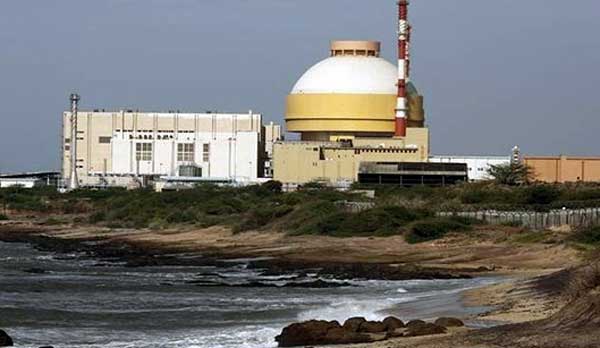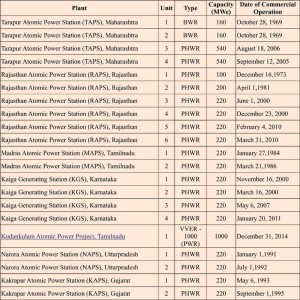Civil Nuclear Energy is only a miniscule portion of the power generation in our country. The sector could not grow in a proper way since Independence due to a variety of reasons. India is one of the largest emitters of green house gases given its dependence on Coal based power plants. India has ambitious plans for rapidly growing its Nuclear Energy sources for civilian use. India has plans to throw open this sector to US, French and Russian Reactor suppliers. In fact there is a rat race to supply these very expensive equipments to India. The questions is whether we have the proper ground rules in place before inviting or allowing the foreign players, so as to safeguard Indian citizens against the risks.
Nuclear Energy: Present Scenario
Nuclear power is the fourth-largest source of electricity in India after thermal, hydroelectric and renewable sources of electricity. As of now, India has 21 nuclear reactors in operation in 7 nuclear power plants, having an installed capacity of 5780 MW and producing a total of 30,292.91 GWh of electricity. Given below is the list of reactors currently in operation, source NPCIL.
In October 2010, India drew up an ambitious plan to reach a nuclear power capacity of 63,000 MW in 2032 but, after the 2011 Fukushima nuclear disaster in Japan, populations around proposed Indian NPP sites have launched protests, raising questions about atomic energy as a clean and safe alternative to fossil fuels.
The Problem: Nuclear fuel reserves
India’s domestic uranium reserves are small and the country is dependent on uranium imports to fuel its nuclear power industry. Since early 1990s,Russia has been a major supplier of nuclear fuel to India.Due to dwindling domestic uranium reserves, electricity generation from nuclear power in India declined by 12.83% from 2006 to 2008.
India has 21 nuclear reactors in operation in 7 nuclear power plants, having an installed capacity of 5780 MW…
Following a waiver from the Nuclear Suppliers Group in September 2008 which allowed it to commence international nuclear trade, India has signed bilateral deals on civilian nuclear energy technology cooperation with several other countries, including France, the United States, the United Kingdom, Canada and South Korea. India has also uranium supply agreements with Russia, Mongolia, Kazakhstan, Argentina and Namibia. An Indian private company won a uranium exploration contract in Niger.
Indo – US Civil Nuclear Agreement: Partially solves the problem
The Indian nuclear power industry is expected to undergo a significant expansion in the coming years, in part due to the passing of the India-U.S Civil Nuclear Agreement. This agreement will allow India to carry out trade of nuclear fuel and technologies with other countries and significantly enhance its power generation capacity. The best thing about this agreement is that India can run all its commercial Nuclear power plants under IAEA safeguards with Imported Uranium.
Planned Nuclear Energy Projects: Implementation hurdles
There are two kinds of planned projects in India, one is the construction of small CANDU type reactors using Pressurised Heavy Water Reactor (PHWR) and the second type using Pressurised Water Reactor (PWR). PWR’s are water-cooled water-moderated light water power reactors being built at Kudankulam and also proposed to be built at Jaitapur (Maharashtra), Mithi Virdi (Gujarat), Haripur (West Bengal) and several other places.
Since Indian entities like NPCIL, BARC does not have the technology for PWR kind of reactor, it has to be purchased from Foreign companies. Thus the hurdles in the implementation of PWR’s are of the following types: 1) Technology and Safety, and 2) Cost.
A nuclear accident like the 2011 Fukushima Daiichi nuclear disaster would have dire economic consequences in heavily populated India…
PWR’s are regarded as safer than PWHR’s but cannot be claimed to be accident free.
Technology and Safety are inter-related since a good design is likely to minimise the chance of accident and vice-versa.
In order to tackle this aspect the Indian Legislators enacted the Nuclear Liability Act 2010 which stipulates that nuclear suppliers, contractors and operators must bear financial responsibility in case of an accident. The legislation addresses key issues such as nuclear radiation and safety regulations, operational control and maintenance management of nuclear power plants, compensation in the event of a radiation-leak accident, disaster clean-up costs, operator responsibility and supplier liability.
A nuclear accident like the 2011 Fukushima Daiichi nuclear disaster would have dire economic consequences in heavily populated India as did the 1984 Union Carbide Bhopal disaster, the world’s worst industrial disaster, covered extensively in
Dominique Lapierre’s 2009 prize winning book Five Past Midnight in Bhopal.
Do we remember Bhopal tragedy? Let me try to refresh the memory of those of us who don’t. A gas leak in a US company Union Carbide’s factory in Bhopal city killed about 20,000 people in 1984 in one of the world’s worst industrial disasters. The Central Government and even the Supreme Court was caught napping in the absence of a Law governing large scale Industrial disasters and its compensation.
…the nuclear liability bill limits the time to make a claim within 10 years. This is considered to be too short as there may be long term damage due to a nuclear accident.
Nuclear Liability Act: Liability Enforceable or Ineffective piece of Legislation
The purpose of this legislation is to hold the manufacturers and Suppliers of Nuclear equipment liable for Accidents that may happen in a Nuclear power plant built with their equipment. The motive behind this legislation is to prevent Bhopal type accidents and if not prevented provide proper,prompt compensation to the victims of a Nuclear Accident as mentioned in the Aims of this Act..
Let us go through some of the Clauses of this Act.
Clause 6– defines the share of financial liability. It states that the liability of an operator for each nuclear incident shall be:
(a) for nuclear reactors having power equal to 10 MW or above Rs. 1,500 crores (i.e. Rupees 15 billion) (b) in respect of spent fuel reprocessing plants, rupees three hundred crores; (c) in respect of the research reactors having thermal power below ten MW, fuel facilities other than spent fuel reprocessing plants and transportation of nuclear materials, Rupees one hundred crores (Rupees 1 billion). However, the Central government may review the operator’s liability from time to time and specify a higher amount and the remaining amount will be paid by the Indian government. If written into the contract, the operator can claim the liabilities from the manufacturer and supplier. But the maximum amount payable by the foreign companies will be limited to a meagre sum of Rs.1500 crore
Clause 17-This clause deals with the legal binding of the culpable groups in case of a nuclear accident. It allows only the operator (NPCIL) to sue the manufacturers and suppliers. Victims will not be able to sue anyone. In reality, no one will be considered legally liable because the recourse taken by the operator will yield only Rs.15 billion (US$220 million).
Clause 18-This clause of the nuclear liability bill limits the time to make a claim within 10 years. This is considered to be too short as there may be long term damage due to a nuclear accident.
The clause takes away the right of the victim to sue the manufacturer, supplier for civil damage and criminal liability. This is totally wrong. Everyone has the right to sue a company if it violates him in a serious way.
Clause 35-It extends the legal binding that the responsible groups may have to face. The operator or the responsible persons in case of a nuclear accident will undergo the trial under Nuclear Damage Claims Commissions and no civil court is given the authority. The country will be divided into zones with each zone having a Claims Commissioner. This is in contrast to the US counterpart – the Price Anderson Act, in which lawsuits and criminal proceedings proceed under the US courts.
Criticism of the Nuclear Liability Law
I will now proceed to criticize the above clauses and the Act in general.
Clause 6– The maximum liability in case of Nuclear Accident is pegged at Rs.15 billion (US$220 million). 1) The operator being NPCIL which itself is a government owned facility. In other words, the government may have to foot the entire bill thereby exonerating the manufacturer/supplier. 2) A paltry sum of $ 220 million for an accident that kills or maims thousands of people! This is insensitivity to the extreme. Are Indian lives cheaper than American, French or Russian Lives? It is a insult to the people of India. The clause should have mentioned at least $1 Billion per thousand person killed or affected, so that liability is dependent on the number of victims and not a fixed sum.
Clause 17 – The clause takes away the right of the victim to sue the manufacturer, supplier for civil damage and criminal liability. This is totally wrong. Everyone has the right to sue a company if it violates him in a serious way.
Clause 18 – Since 10 years is too short a time to know the long term effects of a Nuclear disaster, prudence demands that either the time limit be removed or be extended to 30 years or more.
Clause 35 – What will be the powers of the Claims Commissioner? If he acts on the basis of this Act only then he will be quite ineffective. Civil Law relating to damages and Compensation should be modified and strengthened and victims should be allowed to file suits for damages in civil courts. The cases then may be clubbed together and placed under a Claims Commissioner for speedy delivery of Compensation.
The Insurance route of getting Rs 1500 crore is both insufficient and time consuming. Government needs to have a fund in hand with which it can start spending immediately after a Nuclear accident has occurred.
Constitutionality of this Act
A Public Interest Litigation (PIL) has also been filed against the Act at the Supreme Court of India in 2011, examining the constitutionality of the Act regarding the Right to Life as enshrined in the Constitution of India
Alternative Approach required
The Indian Government should have a alternative approach to extracting money from the Nuclear Equipment Manufacturer/Suppliers. Solely depending on the liability Law is a flawed approach for the following reasons:
- Manufacturers, Suppliers may not pay compensation especially if it runs into Billions of dollars. How will it ensure that they pay up, especially if they are backed by governments of powerful countries like US, France, Russia etc?
- The Insurance route of getting Rs 1500 crore is both insufficient and time consuming. Government needs to have a fund in hand with which it can start spending immediately after a Nuclear accident has occurred.
Thus the government needs to charge the Foreign companies or Foreign Governments a sum of $2 Billion for each reactor that they supply. A sum of $ 1 billion may be used for Land Acquisition, compensation to affected people and creation of basic infractructure for a new power plant like roads, railway lines etc. The other billion dollar amount may be used for purchasing Insurance for that power plant from a local insurance Company. The sum could also be invested into a SIP or Equity based fund which ensures high growth every year. Thus the Indian government will be awash with funds and it can easily pay huge amounts as compensation when the time arrives.
Conclusion
Thus The Civil Liability for Nuclear Damage Act, 2010 or Nuclear Liability Act as it is commonly called is a farcical piece of Legislation that is bound to betray the victims of Nuclear Accident. The present government would do well to either modify it drastically or bring in a new one after throwing the present one into the dustbin of history.







The above all discussion shows that Indians are installing the NPP’s not for the production of electricity for for the sake of a nuclear disaster/accident and then to claim for compensation under civil liability law….!!!